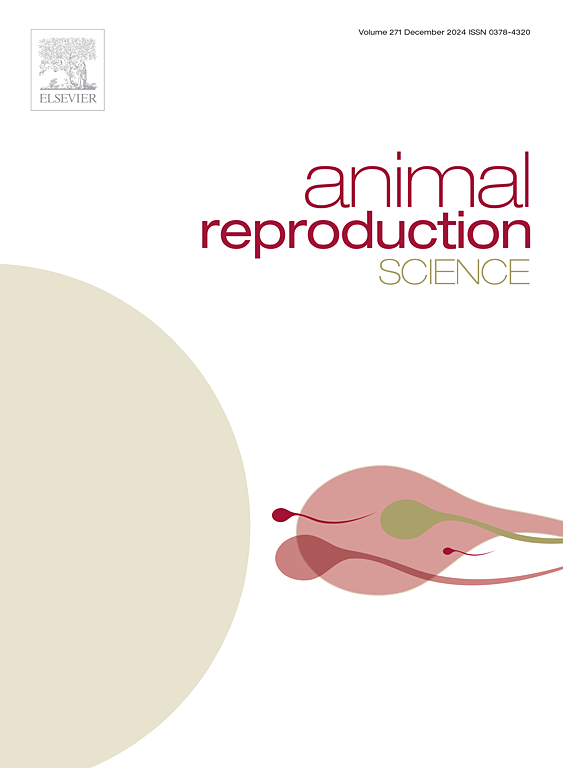Effects of Zinc oxide nanoparticles on llama sperm cryopreservation
IF 3.3
2区 农林科学
Q1 AGRICULTURE, DAIRY & ANIMAL SCIENCE
引用次数: 0
Abstract
Zinc oxide nanoparticles (ZnO-NPs) have been reported to enhance sperm cryopreservation in several species, but their effect on frozen llama semen remains unexplored. This study aims to evaluate the effect of ZnO-NPs on sperm parameters in frozen/thawed llama semen. Fourteen ejaculates, obtained from seven male llamas, were each divided into three equal aliquots. Each aliquot was diluted with 1. AndroMed® with 20 % egg yolk and no ZnO-NPs (AM-EY0, Control); 2. AM-EY supplemented with 50 μg/ml of ZnO-NPs (AM-EY50) and 3. AM-EY supplemented with 100 μg/ml of ZnO-NPs (AM-EY100). Freezing was performed using an automatic machine. Evaluations were carried out on raw semen, immediately after dilution (0 h), and following the freezing/thawing process. Additionally, frozen/thawed samples were incubated at 37 °C and assessed at 15, 90, and 180 min. Data were analysed using Friedman tests, conventional ANOVA, or split-plot design models. The results showed no significant differences in sperm motility patterns, live sperm with intact acrosomes, membrane function, lipid peroxidation, sperm morphology, or DNA integrity among frozen/thawed groups (P > 0.05). A trend toward higher sperm vigour was detected in frozen/thawed samples cryopreserved with 50 and 100 μg/ml of ZnO-NPs (P = 0.08). Moreover, ZnO-NPs did not enhance sperm survival during post-thaw incubation at 37 °C for up to 180 min. In conclusion, supplementation of the AM-EY extender with 50 or 100 μg/ml ZnO-NPs did not provide broad protection against cryodamage in llama sperm. Further studies testing a wider range of concentrations are needed to assess their potential benefits for sperm cryopreservation in this species.
氧化锌纳米颗粒对羊驼精子冷冻保存的影响。
据报道,氧化锌纳米颗粒(ZnO-NPs)可以增强几个物种的精子冷冻保存,但它们对冷冻美洲驼精液的影响尚不清楚。本研究旨在评价ZnO-NPs对冷冻/解冻骆驼精液中精子参数的影响。从七只雄性大羊驼身上获得的十四次射精,每一次被分成三等份。每个等价物用1稀释。AndroMed®含20 %蛋黄,无ZnO-NPs (AM-EY0,对照);2. 添加50 μg/ml ZnO-NPs (AM-EY50);AM-EY中添加100 μg/ml的ZnO-NPs (AM-EY100)。冷冻是用自动机器进行的。在稀释后(0 h)和冷冻/解冻过程后立即对生精液进行评估。此外,冷冻/解冻的样品在37°C下孵育,并在15、90和180 min下进行评估。数据分析采用Friedman检验、传统方差分析或裂图设计模型。结果显示,冷冻/解冻组在精子运动模式、顶体完好活精子、膜功能、脂质过氧化、精子形态或DNA完整性方面均无显著差异(P > 0.05)。用50和100 μg/ml的ZnO-NPs冷冻/解冻后的精子活力有提高的趋势(P = 0.08)。此外,ZnO-NPs在37°C解冻后孵育长达180 min期间并没有提高精子存活率。综上所述,添加50或100 μg/ml ZnO-NPs的AM-EY扩展剂对骆驼精子的低温损伤没有广泛的保护作用。需要进一步的研究测试更大范围的浓度,以评估它们对该物种精子冷冻保存的潜在益处。
本文章由计算机程序翻译,如有差异,请以英文原文为准。
求助全文
约1分钟内获得全文
求助全文
来源期刊

Animal Reproduction Science
农林科学-奶制品与动物科学
CiteScore
4.50
自引率
9.10%
发文量
136
审稿时长
54 days
期刊介绍:
Animal Reproduction Science publishes results from studies relating to reproduction and fertility in animals. This includes both fundamental research and applied studies, including management practices that increase our understanding of the biology and manipulation of reproduction. Manuscripts should go into depth in the mechanisms involved in the research reported, rather than a give a mere description of findings. The focus is on animals that are useful to humans including food- and fibre-producing; companion/recreational; captive; and endangered species including zoo animals, but excluding laboratory animals unless the results of the study provide new information that impacts the basic understanding of the biology or manipulation of reproduction.
The journal''s scope includes the study of reproductive physiology and endocrinology, reproductive cycles, natural and artificial control of reproduction, preservation and use of gametes and embryos, pregnancy and parturition, infertility and sterility, diagnostic and therapeutic techniques.
The Editorial Board of Animal Reproduction Science has decided not to publish papers in which there is an exclusive examination of the in vitro development of oocytes and embryos; however, there will be consideration of papers that include in vitro studies where the source of the oocytes and/or development of the embryos beyond the blastocyst stage is part of the experimental design.
 求助内容:
求助内容: 应助结果提醒方式:
应助结果提醒方式:


